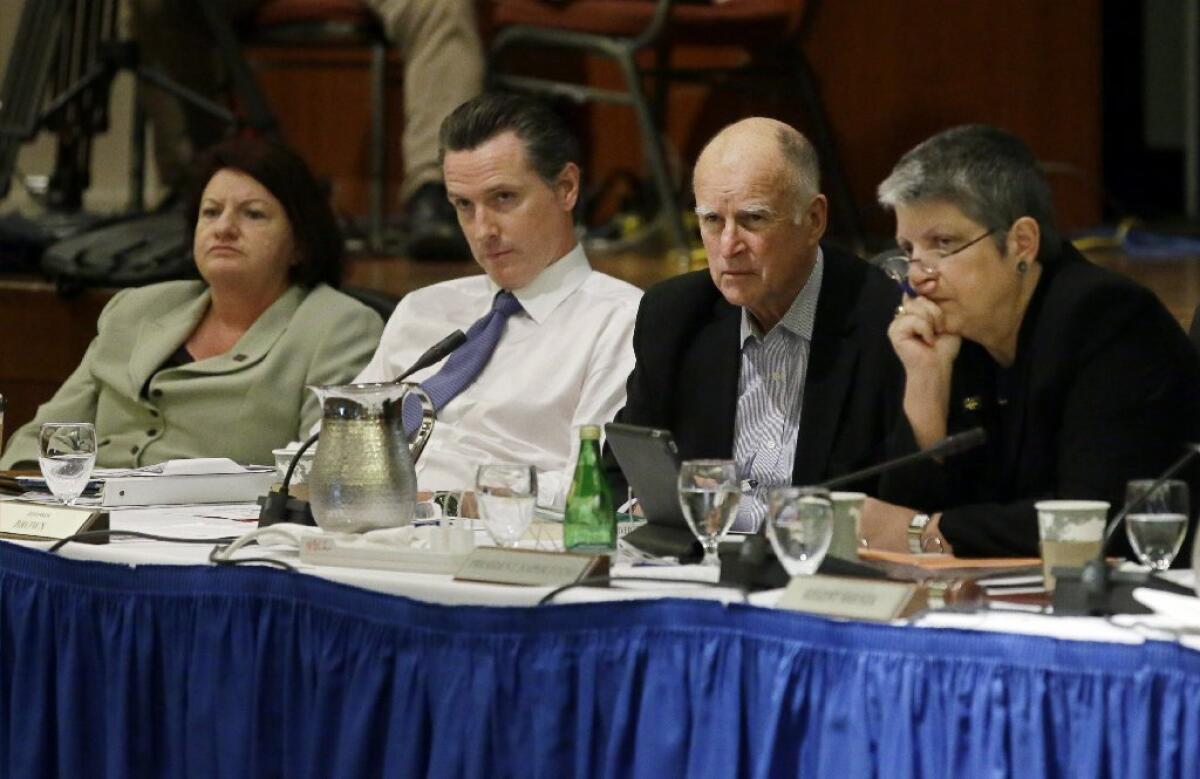Op-Ed: The tangle behind the UC funding spat

- Share via
It looks like a classic game of budget chicken: Gov. Jerry Brown tells the University of California not to raise tuition again. When the regents vote to do it anyway, the governor threatens to withhold $120 million from UC’s funding for next year unless the regents back down.
Before UC raises tuition, he argues, it should tighten its belt: more restraint in raising the pay of UC administrators and faculty, more online instruction, more teaching and less research.
Paradoxically, Brown also urged UC to admit fewer foreign and out-of-state students who, because of the high tuition they pay, are cash cows for Berkeley, UCLA and UC San Diego, the campuses that attract most of them. With fewer outlanders, there’d be more room for Californians.
UC argues that out-of-state students add cosmopolitan diversity to their campuses, but when it allocated more space for them in the past few years, it was also sending a not-so-subtle message to the politicians in Sacramento, who had been stiffing the university on its funding.
In 1990-91, according to Nathan Brostrom, UC’s chief financial officer, the university got $18,000 in inflation-adjusted dollars per student from the state; this year it’s getting $8,280. The $2.8-billion total it gets this year is exactly the same, in absolute dollars, that it got in 1997-98, when the system was educating 75,000 fewer students.
Beyond the details of the Brown and Napolitano spat, there’s a tangle of tougher — and — more fundamental issues. For a couple of decades a retired UC Berkeley physics professor named Charles Schwartz has been generating numbers from UC’s own data to show that in fact undergraduate tuition — now roughly $12,000 a year, and slated to exceed $15,500 within four years if the regents’ tuition increases stay in place — pays for nearly twice the actual cost of undergraduate instruction. The rest, Schwartz says, subsidizes graduate education and research.
Brostrom says Schwartz’s analysis is wrong, but it raised enough questions that in 2013 the Legislature enacted AB 94 requiring the university to, among other things, generate periodic reports and more precise accounting on how it actually spends its money.
When the first deadline came last fall, the university, pleading for more time to generate better numbers, provided no more than a place holder with no real data. UC’s information systems, Brostrom said, are “very complicated.” Still, in an interview with me he promised a new report within a couple of weeks.
In fact, UC doesn’t know exactly how it spends its money — and maybe it honestly can’t know. Is the salary for a teaching assistant — who is also a doctoral candidate working in her mentor’s lab — money for undergraduate instruction, for research or for graduate education? How do you distinguish a professor’s teaching from his research on a spreadsheet? How do you allocate the budget for the library or for the custodians and groundskeepers?
More fundamentally, how do you resolve the inherent tension between trying to be a highly ranked, selective research institution competing with Harvard, Stanford and other lavishly endowed private universities and trying to be a public university as well? Can you be meritocratic and democratic too?
Students and many UC employees, including some faculty, complain loudly — and justifiably — about the fat salaries and benefits senior university administrators are paid. Is the chancellor at Berkeley really worth the $486,000, plus benefits, that he gets? The governor doesn’t think so, and neither do a lot of people on the Berkeley campus.
But UC doesn’t exist outside the rest of our corporate culture, in which the gaps between executives and the people who work for them get wider by the minute. If you don’t pay your new budget guy or your personnel manager what he wants, will you lose him to Morgan Stanley or GE? How much will the quality of education be affected if you have to hire a second-choice provost, professor or dean?
Although he’s a Berkeley graduate, Brown, with his Jesuit seminarian’s streak of austerity, was never known as a warm friend of the University of California — or probably of any other elite institution. In his first round as governor, starting in 1975, he was less generous in funding UC than Ronald Reagan, his predecessor, had been.
Because of the battle of the budget, there’s now to be a Select Advisory Committee on the Cost Structure of the University — actually a committee of two, Brown and UC President Janet Napolitano — to, in the words of a memo prepared for this week’s regents meeting, “develop and evaluate proposals to reduce the University’s cost structure, while improving access, quality, and outcomes.”
They may be able to resolve the immediate issue, because compared even with the inadequate $2.8 billion that the state kicks in this year, $120 million is peanuts. It ought to be an easy issue to compromise on.
Nonetheless, like other major public universities, UC is inexorably privatizing, relying ever more on funding from sources other than the state. Brown, once famous for urging Californians to “lower expectations,” may be a cheapskate, but the privatization started long before he took office four years ago, and it will probably continue long after he’s gone.
Peter Schrag, the former editorial page editor of the Sacramento Bee, is the author most recently of “Not Fit for Our Society: Immigration and Nativism in America.”Follow the Opinion section on Twitter @latimesopinion
More to Read
A cure for the common opinion
Get thought-provoking perspectives with our weekly newsletter.
You may occasionally receive promotional content from the Los Angeles Times.






